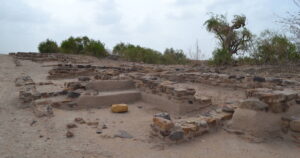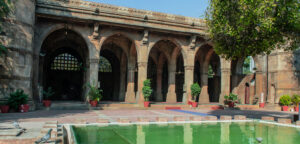From the white Rann of Kutch to the blue waters of Daman and Diu, to the golden-colored Somnath Temple and other fine works of marble, Gujarat offers a diverse palette of attractions. From Rajkot, the City of Paintings (Chitranagri), to Surat, the City of Silk, to Anand, the Milk City (renowned for its high milk production), and the grand festival of Uttarayan with its colorful kites in Ahmedabad, Gujarat is well-known for its beauty among tourists.
Discover the most iconic Historical places of Gujrat
What is even more amazing is its history, which is still present in the form of monuments acting as milestones of every era. Join us on this historical journey where we discover the 9 historical places in Gujarat that will take you through the timeline of India’s history.
1. SOMNATH TEMPLE
Somnath, a land of rivers and a ‘Triveni’ where the three rivers ‘Kapila,’ ‘Hiran,’ and ‘Saraswati’ meet, is home to the Somnath Temple. This temple is one of the Four Hindu Pilgrimages (Chaar Dham), one of the 12 Jyotirlingas, and a monument of great historical importance.
The history of the temple dates back to ancient times, as it is believed to have been built by the Moon God, Soma (thus the name, Somnath), as a dedication to Lord Shiva. While some sources suggest that the Somnath Temple and the Indus Valley Civilization existed simultaneously, others associate it with the Mahabharata (Panch Pandav Gufa). Tracing the temple’s origins precisely is challenging.
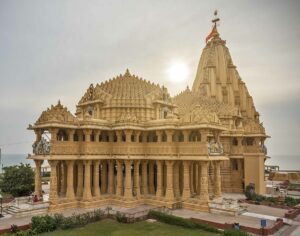
The temple underwent multiple destructions led by several Muslim rulers and invaders, resulting in its reconstruction almost seven times. The present temple was rebuilt post-independence when historians and archaeologists noticed that the temple was slowly taking the shape of a mosque.
The honey-colored architecture is a marvel built upon its several remnants, with the color of the new and old stone showcasing the difference. It is an intricately carved, two-level temple with a pillared Mandapa and 212 relief panels.
2. SABARMATI ASHRAM
The Sabarmati Ashram, one of the most significant historical monument in Gujarat, was the residence of Mahatma Gandhi and his wife. Situated on the banks of the Sabarmati River, this Ashram has witnessed many of Gandhi’s life stories, including his periods of good and bad health, and numerous protests, most notably the famous Dandi March. Mohandas Karamchand Gandhi, a Gujarati himself, was born in Porbandar in the state of Gujarat. However, the Ashram was not limited to being Gandhi’s residence. It also served as a school that focused on the advancement of the nation in every aspect by promoting quality education, manual labor, agriculture, and more. The Bhagavad Gita was recited here every day.
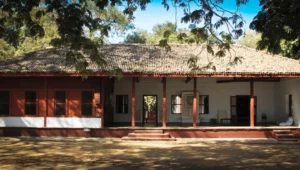
The Dandi March, or the Salt Satyagraha, started from here, led by Gandhi on March 12, 1930. This led to several protests and a mass act of civil disobedience, which resulted in the British government seizing the Ashram.
The Ashram was later restored by the locals to preserve its essence, and it has now been turned into a museum, featuring an exhibition with multiple antiques from Gandhi’s time.
Due to its significant role in the act of gaining independence in India, the Ashram was later declared a national monument.
3. RANI KI VAV-A PLACE OF HISTORICAL IMPORTANCE
Historical monuments in Gujarat include the stunning Rani ki Vav, a stepwell located on the banks of the Saraswati River. Constructed in the 11th century by Udayamati, the wife of Chaulukya King Bhima I, Rani ki Vav exemplifies the grandeur of ancient Indian architecture.
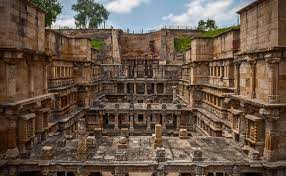
The construction of both Rani ki Vav and the Modhera Sun Temple took place in the same century. The stepwell is divided into seven levels of stairs leading to a common reservoir, further adorned with sculptures of deities and other mythological characters. The level of detailing of these carvings are remarkable, showcasing the artistics skills of the sculpturers of the time.
Designated as a UNESCO World Heritage in 2014, Rani ki Vav is yet another marvelous example of delicate and intricate carvings, showcasing the beauty of Indian architecture. Rani Ki Vav, or the Queen’s Stepwell, is one of the many UNESCO World Heritage Sites that the state of Gujarat is home to.
Fact: The Rs.100 note features Rani ki Vav on its backside
4. DHOLAVARI: HERITAGE SITE
5. SIDI SAIYYED MOSQUE
6. DIU FORT
The Diu Fort, located on Diu Island near Gujarat, exemplifies an Indo-Portuguese style of architecture and stands as a testament to the Portuguese influence in India. As one of the notable historical monuments in Gujarat, the fort features massive thick walls, bastion towers, and both the Land Gate and Sea Gate, providing visitors with panoramic views of serene beauty. Inside the fort, St. Thomas Church is another fine example of Portuguese architecture.
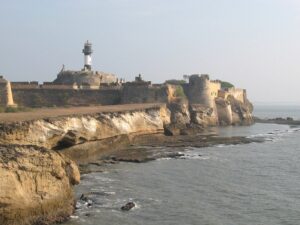
The fort’s location is prime, with the Arabian Sea on one side and lush green lands on the other. Visiting Diu Fort offers a chance to explore the blend of Portuguese and Indian influences through its historical artifacts, architectural features, and cultural narratives. It truly represents one of the best historical places in Gujarat.
7. TEEN DARWAJA
Located in the city of Ahmedabad is Teen Darwaja (Teen refers to three and darwaja means door). A fine example of Persian and Indian architecture, Teen Darwaja is a popular monument near the old city of Ahmedabad. The three magnificent doors showcase elegant carvings and ornamental beauty. It was built by Ahmad Shah I (the emperor after whom Ahmedabad is named) right after the foundation of the city and was completed in 1415.
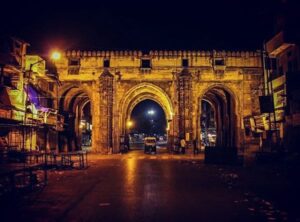
Teen Darwaja is a perfect alternative to your usual ‘Mangal Bazaar’ with shopkeepers selling jewelry, readymade garments, festive items like firecrackers for Diwali or kites for Uttarayan, pooja items, old coins, and more. Visitors also pay their homage to the Bhadrakali Temple and the tomb of Khwaja Siddiqiue Kotwal. As one of the best historical places in Gujarat, Teen Darwaja offers a glimpse into the rich architectural and cultural heritage of the region.
8. GOP TEMPLE
The Gop Temple, a Sun Temple located in Zinavari village of Jamnagar, Gujarat, is believed to be the oldest surviving stone temple, built around the last quarter of the 6th century in Saurashtra, Gujarat. Situated on the bank of the Vartu River, this temple is an unusual architectural variation on the Nagara style.

Originally, the temple was larger and included a mandapa and walls that were plain without any carvings or decorations. However, much of it is now damaged and appears to be demolished. Despite its condition, the Gop Temple remains a significant historical site, reflecting the rich architectural heritage of Gujarat. If you are fond of Indian temples then you must visit this blog 11 Historical Temples of South India
9. MODHERA SUN TEMPLE
Dedicated to the Hindu God of the Sun, Surya, this temple is yet another marvel of Indian architecture. Located in the Mehsana district of Gujarat on the bank of the Pushpavati River, the temple was built by Bhima I of the Chaulukya dynasty in 1027 CE. It features a Gudhamandapa as the shrine hall, a Sabhamandapa as the assembly hall, and a Kunda as the reservoir.
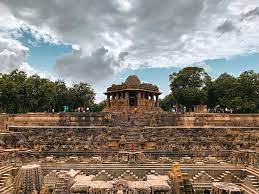
During 1024-25 CE, Bhima’s Kingdom was invaded by Mahmud of Ghazni, resulting in the defeat of 20,000 soldiers. Historian A.K. Majumdar predicts that this temple was built to commemorate this defeat.
If you love cultural and historical festivals, January is the best time to visit. Right after the Uttarayan festival, a three-day fest known as the Uttardhara Mahotsav is organized on the temple premises.
However, worshiping in the temple is now restricted, and it is protected as a monument under the Archaeological Survey of India.
CONCLUSION
Gujarat is one of the few states in India where history can be traced back to the dawn of human existence. It begins with the Indus Valley Civilization and spans to modern history, including India’s independence, being home to many Indian freedom fighters, including Mahatma Gandhi. It continues to create history by being the home to the tallest statue in the world, the Statue of Unity, which stands as a tribute to Sardar Vallabhbhai Patel.
While this blog covers the 9 historical monuments of Gujrat, the state offers a rather wider spectrum of experience to the traveler ranging from historical monuments to natural wonders, beautiful crafts, cuisines and colorful festivals.
To know more about the different histories and cultures of India, follow our blog.
Check out our blog to know /11-historical-temples-of-south-india/


